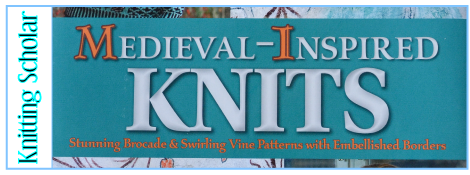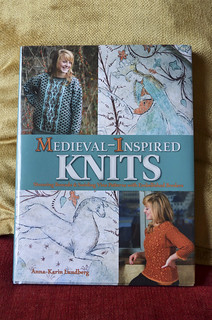First, the facts:
Title: Medieval-Inspired Knits: Stunning Brocade and Swirling Vine Patterns with Embellished Borders
Author: Anna-Karin Lundberg
Published by: Trafalgar Square Books, 2012
Pages: 128
Type: Patterns
Chapters:
Introduction
Albertus Pictor
The Malar Valley School
Tierp Group
Knitting Techniques
The In-Depth Look:
In its own way, this book is a masterpiece.
The author spent years studying medieval churches in Sweden. She says, “Many of the churches are richly decorated with frescos utterly overflowing with luxuriant swirling vines, majestic stenciled patterns, graceful borders, and exciting color combinations. Besides embellishing and framing biblical scenes, painted decorations of various types were employed to emphasize the church interior’s architecture, for example on the vault ribs, around the portals, and bowed windows. In the old Swedish peasant society, for centuries, a person could draw inspiration from these interiors to apply to various types of decorative handwork: furniture making, wood carving and many textile techniques. In my case the inspiration from these fantastic decorative paintings led to … a collection of knitting patterns fur unique hand knitted garments where the painted embellishments have been transformed to contemporary knitting pleasure. A little bit of the Middle Ages to use for everyday–or more festive occasions–in our times.”
The source photographs are beautiful, and the details given–when a specific motif from a doorway or an arch is highlighted and then recreated in knitting–well, it’s gorgeous. The colors, the details, the designs … all uniformly impressive. (Not only for the original, ancient artwork, but for the transposition into yarn.)
The actual sweater designs themselves, though? (Because almost every pattern in this book is for a sweater, mostly for women, but also for men and children.) The sweaters are almost entirely basic, drop-shouldered, color-work rectangles, reminiscent of the Alice Starmore designs from the 80s.
Now, considering much of the point is to recreate the gorgeous colorwork, I understand that the designer would want to keep the “canvas” as simple as possible. Except for some basic shaping at the necklines, there is almost no shaping to any of these designs. The classic, drop-shouldered style (and it IS a classic) is easy to knit–especially when doing colorwork. The problem, though, is that this makes just about every design here … bulky. Square, thick with color, busy with pattern and … bulky. I can’t imagine wearing any of them as anything other than outerwear, and considering how even the models look rather heavy, I can’t imagine these would be, um, flattering to wear.
This is the hard thing, you see. Classic, drop-shouldered pullovers have been around forever … but they predate things like central heating. Most people I know who wear sweaters, wear them around the house, inside their heated offices, or under a heavy coat when they need to go out, and the sweaters here are all a little too warm, too busy, to do that comfortably. (And I remember trying to squeeze my lovely, handknit drop-shouldered sweaters into my coat during the 90s. It wasn’t easy.)
It makes me sad to say that my general inclination with the designs in this book, therefore, would be to turn most of them into things like pillows so that I could enjoy the beauty of the patterns and colors (because they are beautiful), but wouldn’t have to try wearing them. I’m torn, you see, between loving (truly loving) the masterwork of converting the art in those amazing Swedish churches into something modern and knitted and the realization that the finished product looks so, well, dated for modern eyes. Sweaters these days tend to be fitted, shaped, and meant for layering, and these designs, well … aren’t. They’d make admirable outerwear, but if you’re looking for a sweater to wear around the house or out shopping, these patterns probably aren’t for you–no matter how impressively gorgeous the colorwork is.
This book can be found at Amazon.com.
Want to see bigger pictures? Click here.

My Gush:



